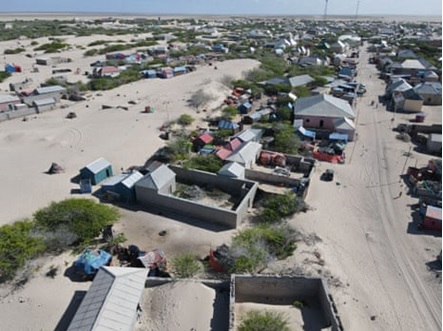
As deforestation and fierce winds compound the climate crisis-driven drought, sand dunes are burying the medieval port of Hobyo. Will pledges to green the desert save families already displaced by war?
Hussein Karshe paces back and forth across the sand on the outskirts of the coastal town of Hobyo. Beneath the soft white dune lie the remains of the two-bedroom house he built for his family in 1993. A few sticks buried below the sand are the only visible sign of the building where his six children were born. Karshe lived there for nearly 20 years, supporting his family by selling goats.

But in 2011 heavy sandstorms covered the ground around his home. Over the next year the sand accumulated, creeping up the external walls of the house and blowing into the rooms. At first Karshe tried to keep the sand at bay by scooping it out with his hands or a small shovel, but his efforts proved futile.
Realising he was powerless to stop it, Karshe could only look on as the sand built up inside the rooms. He decided to build a new house nearby, hoping that the sandstorms that regularly blast this stretch of Indian Ocean coastline would reduce in ferocity and that the local authorities might provide some support to those affected.
Neither of those things happened. After three years, sand engulfed the new home and the family were forced to move again.
Today, the 70-year-old former air force technician lives with his wife and daughters in two tents made from cloth, cardboard, car wheels and other scraps. Every morning he leads his herd of goats inland in search of grazing. Repeated droughts mean he sometimes has to travel for up to two days to find fertile ground.
Karshe moved to the port of Hobyo from Somalia’s capital, Mogadishu, after the collapse of the central government in 1991, hoping that the town, in the Mudug region of central Somalia, would be a safe haven from the civil war that tore much of the country apart. He could not have predicted that the climate crisis would displace his family again.
“As you can see, my [second] house is succumbing to sand,” he says, pointing to the knee-deep sand in the rooms as the metal roof creaks in the wind. “It’s all I have left after three decades in Hobyo. I’ve lost everything. All I have left are memories.”
Founded in the 13th century during the Ajuran empire, Hobyo became a hub for piracy, an activity that peaked in 2009-10. Since the decline in piracy, attention has shifted from criminal activity along the coast to the region’s environmental degradation.
Despite contributing less than 0.08% of global emissions, Somalia is one of the most climate-vulnerable countries in the world. Droughts, strong winds and soil erosion are just some of the effects that have worsened over the past two decades as the climate crisis has intensified, causing extreme suffering, including near-famine conditions and mass displacement.
On the coast people say they are more vulnerable than ever to sandstorms that have buried homes, shops, schools and hospitals. In Hobyo, home to about 11,000 people, a hospital funded by a local man, Sheikh Hassan Hussein, was buried in sand just a year after it was built in 2018.
There are fears that the town’s main hospital, where sand is more than a metre high around some of the external walls, will also be buried if no action is taken soon.
Mohamed Mohamud, from the Somali conservation organisation Greenwatch Trust, says: “Wind is one of the factors that is affected by climate change. If you ask the coastal communities, they are saying that the wind is stronger than ever, in comparison to the last 30 years. They said [strong winds] existed before but [they are] faster.”
Read more: ‘Swallowed by the sand’: Somalia’s coastal towns succumb to the desert
Source: The Guardian


Leave a Reply